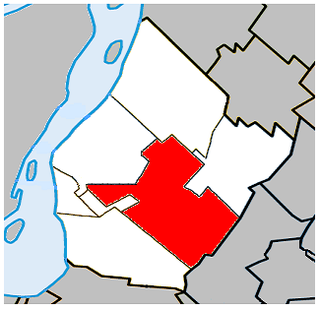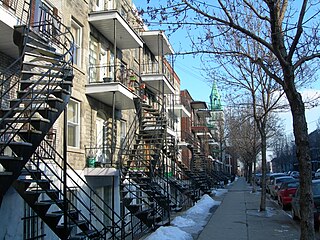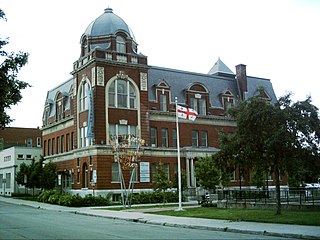
Habitat 67, or simply Habitat, is a housing complex at Cité du Havre, on the Saint Lawrence River, Montreal, Quebec, Canada, designed by Israeli-Canadian-American architect Moshe Safdie. It originated in his master's thesis at the School of Architecture at McGill University and then an amended version was built for Expo 67, a World's Fair held from April to October 1967. Its address is 2600 Avenue Pierre-Dupuy, next to the Marc-Drouin Quay. Habitat 67 is considered an architectural landmark and a recognized building in Montreal.

Saint-Hubert is a borough in the city of Longueuil, located in the Montérégie region of Quebec, Canada. It had been a separate city prior to January 1, 2002, when it along with several other neighbouring south shore municipalities were merged into Longueuil. Saint-Hubert had a population of 78,336 in 2006. The area of the borough is 65.98 km2 (25.48 sq mi). Longueuil's city hall is now located in Saint-Hubert. Saint-Hubert is located about 14 kilometres (8.7 mi) from downtown Montreal.

Hochelaga-Maisonneuve is a neighbourhood in Montreal, Canada, situated in the east end of the island, generally to the south of the city's Olympic Stadium and east of downtown.

Verdun is a borough (arrondissement) of the city of Montreal, Quebec, located in the southeastern part of the island.
Pointe-Saint-Charles is a neighbourhood in the borough of Le Sud-Ouest in the city of Montreal, Quebec, Canada. Historically a working-class area, the creation of many new housing units, the recycling of industrial buildings into business incubators, lofts, and condos, the 2002 re-opening of the Lachine canal as a recreation and tourism area, the improvement of public spaces, and heritage enhancement have all helped transform the neighbourhood and attract new residents. Community groups continue to be pro-active in areas related to the fight against poverty and the improvement of living conditions.

The urban agglomeration of Montreal is an urban agglomeration in Quebec, Canada. Coextensive with the administrative region of Montreal, it is a territory equivalent to a regional county municipality (TE) and a census division (CD), for both of which its geographical code is 66. Prior to the merger of the municipalities in Region 06 in 2002, the administrative region was co-extensive with the Montreal Urban Community.

Place des Arts is a major performing arts centre in Montreal, Quebec, Canada, and the largest cultural and artistic complex in Canada.

Mercier–Hochelaga-Maisonneuve is a borough of Montreal, Quebec, Canada located in the southeastern end of the island.

Le Sud-Ouest is a borough (arrondissement) of the city of Montreal, Quebec, Canada.
Ville-Émard is a neighbourhood located in the Sud-Ouest borough of Montreal, Quebec, Canada.

Little Burgundy is a neighbourhood in the South West borough of the city of Montreal, Quebec, Canada.

De Maisonneuve Boulevard is a major westbound boulevard located in downtown Montreal, Quebec, Canada. It is named after the founder of Montreal, Paul Chomedey de Maisonneuve. It is a one-way street westbound.

The Robillard Building once located at 974, boulevard Saint Laurent, was a landmark building in Montreal, Quebec, Canada, situated in Montreal's Chinatown on the corner of rue Viger and boulevard Saint Laurent. On 17 November 2016, the building was destroyed by fire. Despite being a famous landmark, the Robillard Building did not have a heritage status and was not rebuilt. The site remained empty from 2016 until 2022. As of 2022, a condominium is being built on the site.

Côte-Saint-Paul is a neighbourhood located in the Southwest Borough of Montreal, Quebec, Canada.
René G. Lépine was a Canadian real estate developer and philanthropist. Lépine was the chairman of Groupe Lépine, a real estate development and investment firm he founded in 1953. He is widely considered one of the most influential French Canadian real estate developers of his time. His companies developed over $5 billion of real estate in Canada and the United States since the 1960s. He also owned a portfolio of multifamily and retail properties in Montreal and Ottawa. Lépine developed many buildings considered landmarks in Montreal, including the Olympic Village and Le Sanctuaire du Mont-Royal. Lépine is also credited with having developed the first condominiums in Montreal in 1981.
Michel Leduc was a Canadian doctor and politician. Leduc served as the Mayor of former borough of LaSalle, Quebec, from 1983 until December 31, 2001. Leduc was the last Mayor of LaSalle. The borough was annexed by the neighbouring city of Montreal on January 1, 2002. He was born in Châteauguay, Quebec.
This is a list of small shopping centres in the island of Montreal.

Le Triangle is a redeveloped condominium district in Côte-des-Neiges–Notre-Dame-de-Grâce borough of Montreal, Quebec, Canada. Bounded by De la Savane, Mountain Sights and Jean Talon Street, the district was expected to be home to 1,200 residential units by the end of 2012, with a target of 4,200 units in total. 75% of the land is planned to be set aside for urban open space. As of March 2012, discussions were under way with the Commission scolaire de Montréal for the construction of an elementary school.
The boroughs of Montreal, like the rest of Canada and the world, have been individually impacted by the COVID-19 pandemic.












